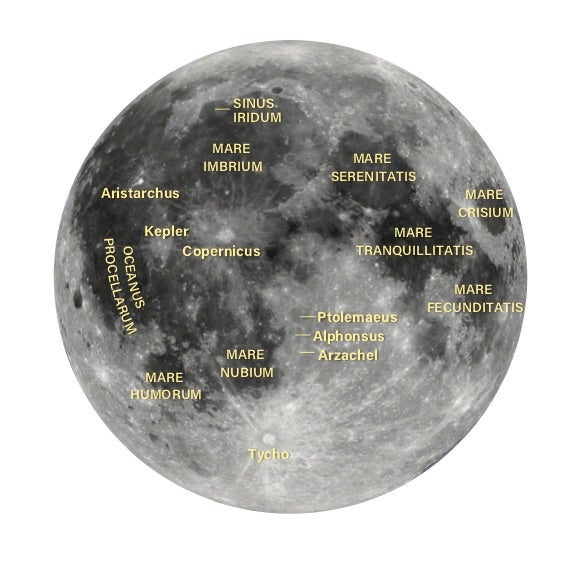Dark skies are in short supply during June, as we usher in summer and the shortest nights of the year. So rather than focus on what we don’t have, let’s look at what we do.
Our Moon is visible long before the Sun sets, after it rises, and even in broad daylight, depending on the phase. It is decorated with a number of impact craters and lunar maria — large, dark plains formed by ancient volcanic activity. Early astronomers once mistook these locations for seas (hence the Latin name maria).
Let’s begin with New Moon, which occurs June 10. While you won’t see the Moon that night, you can see it the night after, as the young waxing crescent lies just above the horizon, bathed in the deepening twilight glow. It’s a beautiful sight through binoculars — especially one night later, when Venus appears to its south.
Three nights after New Moon, Mare Crisium comes into full view. This large, oval plane measures 270 by 350 miles (435 by 560 kilometers), with the long dimension running east-west. However, its long axis appears to extend north-south, an illusion caused by the Moon’s curvature.
Five nights after New Moon, dawn has crossed Mare Fecunditatis and Mare Tranquillitatis. It was along the southwestern edge (southeast in our sky) of the latter that Apollo 11 landed 52 years ago next month. As you look its way, hear in your mind the immortal words of mission commander Neil Armstrong as he took “one small step for [a] man, one giant leap for mankind.”
Mare Tranquillitatis flows northward into Mare Serenitatis. The last mission to the Moon, Apollo 17, landed near its eastern “shore” in November 1972.
First Quarter begins to cast light on Mare Imbrium. The eastern limit of Mare Imbrium is marked by the Apennine Mountains, which curve into the terminator’s darkness.
It is usually best to search for individual craters when they lie near the terminator, since the shadowing makes them easier to identify. Can you spot the north-to-south trio of Ptolemaeus, Alphonsus, and Arzachel along the First Quarter terminator? Ptolemaeus is the largest of the three, spanning 95 miles (153 km). Alphonsus is 73 miles (119 km) across, while Arzachel measures 60 miles (96 km).
The Moon’s southern hemisphere is cluttered with so many craters that it is hard to distinguish individuals through binoculars. Two, however, stand out. Sunrise on day eight of the lunar cycle sheds light on Clavius, the second-largest crater on the Moon’s nearside. This monstrous impact feature appears oval-shaped from Earth, but that’s only because of the lunar globe’s curvature. It’s actually circular, 144 miles (231 km) in diameter.
This same night, a spark is struck to the lower right of Clavius as the crater Tycho enjoys sunrise. As the phases progress toward Full Moon, watch Tycho’s brilliant system of rays turn that spark into a conflagration of bright beams of ejecta spraying northward across the Moon.
As the waxing gibbous phases advance, sunlight uncovers the rest of Mare Imbrium, including a dent along its northern edge known as Sinus Iridum or the Bay of Rainbows. Sinus Iridum is the remains of a large crater whose south wall was subsequently breached by lava from Mare Imbrium. The bay’s “mouth” spans 155 miles (249 km). As the days march onward, the terminator reveals Mare Humorum, Mare Nubium, and finally the largest mare of all, Oceanus Procellarum, which has three brilliant craters. At nearly twice the size of Alaska, the Ocean of Storms is the only lunar maria to earn the title “ocean.”
The first of Oceanus Procellarum’s craters to see sunlight is Copernicus, famous for its dazzling rays that burst into view against the darker surroundings. By Full Moon, the rays are visible without any optical aid at all. To its west (our east) sits the crater Kepler. While Copernicus measures 58 miles (93 km) across, Kepler is just one-third as large. Yet Kepler is one of the most prominent craters on the Moon, thanks to its bright ray pattern. It may remind you of a miniature Copernicus. The third bright crater adorning Oceanus Procellarum is Aristarchus. Like Copernicus and Kepler, Aristarchus is highlighted by a magnificent system of rays extending from its rim into the mare.
And that brings us to Full Moon. As our satellite continues in its orbit, the waning phases that follow turn the terminator into the sunset line. It’s fun to stay up late or rise early to watch each of the features listed here say goodnight as the Sun drops below their western horizon.
Questions, comments? Contact me through my website, philharrington.net. Until next month, remember that two eyes are better than one.










